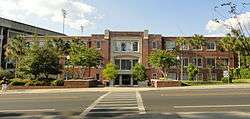Florida Gymnasium
The Florida Gymnasium (commonly known as the "Florida Gym" and formerly nicknamed "Alligator Alley") is a historic building located on the campus of the University of Florida (UF) in Gainesville, Florida. It opened in 1949 as a 7,000-seat multi-purpose arena and served as the home court of the Florida Gators men's basketball team and other UF indoor sports programs for over thirty years, acquiring the nickname of "Alligator Alley" during that time.[1]
Florida Gymnasium | |
 | |
  | |
| Location | Gainesville, Florida |
|---|---|
| Coordinates | 29°38′56″N 82°20′50″W |
| Built | 1949 |
| Architect | Rudolph Weaver and Guy Fulton |
| Architectural style | Collegiate Gothic |
| Website | Official site |
The Stephen C. O'Connell Center opened in 1980 and became the new home of UF's indoor sports teams. The Florida Gym was extensively redesigned and renovated in the 1980s and again in the 1990s to replaced the former seating area with classrooms, laboratories, offices, and other educational facilities to house the University of Florida College of Health and Human Performance (HHP). The center of the building still features a basketball court which is used for student recreation, small assemblies, and HHP class activities.[2]
History
Earlier facilities
The University of Florida's first indoor sports facility was the University Gymnasium, a narrow brick building that opened in 1919. The school's men's basketball team used the University Gym for practices and games, but since the building was designed for general student recreation, there was little room for spectators. By the mid-1920s, the university had decided that it was not suitable for hosting intercollegiate sports programs and a larger gymnasium was needed.[1]
The university's funding declined with the onset of the Great Depression, making the construction of a new brick gymnasium cost prohibitive. Instead, a wooden facility dubbed the "New Gym" was built directly adjacent to the University Gym as a temporary home for the school's indoor sports teams. However, an ongoing lack of funds throughout the 1930s resulted in Gator basketball teams using the New Gym for over 20 years.
Alligator Alley
Design work on a larger gymnasium was started in the early 1940s by university architect Rudolph Weaver, but the project was postponed during World War II. Plans were completed by Guy Fulton after the war, and the Florida Gymnasium finally opened in 1949, soon after the university became co-educational.[3] The original University Gymnasium became the Women's Gymnasium, and the "New Gym" was converted into a rehearsal space for the university's marching bands.
The Florida Gym soon gained a nickname: Alligator Alley. It was a difficult venue for opponents because the seating was very close to the court and, when full, the noise level was "deafening". However, it had no air conditioning and few amenities, and the court had to be shared by all UF indoor sports programs. As years passed, it was increasingly seen as small and outdated, and was compared to a "dismal and dreary old high school gym" by observers.[4] By the early 1970s, Florida was the only school in the Southeastern Conference without a modern basketball facility, a factor that affected the recruiting of top players and held back the growth of its long-mediocre basketball program.[5]
The university began planning for a much larger multi-purpose sports arena in the mid-1970s, and the O'Connell Center opened in December 1980 as the new home for all of UF's indoor athletic programs.[6]
Current uses

The Florida Gymnasium was gradually adapted to other uses during the 1980s. The court was used primarily as a general student recreation center and occasional assembly hall while a series of renovations repurposed some of the surrounding space for use by the College of Health and Human Performance. In the mid-1990s, the much larger Southwest Recreation Center opened across campus, and a major renovation of the Florida Gym removed the last of the original seating sections and added many modern classrooms, laboratories, offices, and meeting rooms. The basketball court remains in the center of the building and is still used for student recreation and other purposes.[7][2]
In 2008, Florida Gymnasium became a contributing property in the University of Florida Campus Historic District which was added to the National Register of Historic Places on April 20, 1989.[8][9]
See also
- Buildings at the University of Florida
- History of the University of Florida
References
- Kevin M. McCarthy and Murray D. Laurie, Guide to the University of Florida and Gainesville, Pineapple Press, Sarasota, Florida, pp. 171–173 (1977).
- "Our Facilities - HHP". hhp.ufl.edu. UF College of Health and Human Performance. Retrieved 11 February 2020.
- Official Historical profile, UF Historical Campus website
- "Alligator Alley Becomes Snakepit". UPI. 13 January 1976.
- Koss, Bill (1996). Pond birds : Gator basketball : the whole story from the inside. Gainesville, FL: Fast Break Press Distributed by University Press of Florida. ISBN 0813015235.
- Brockway, Kevin. "Dome Sweet Home". The Gainesville Sun. Retrieved 14 December 2016.
- "Florida Gym Basketball Courts". University of Florida.
- "National Register of Historic Places Listings".
- Crabbe, Nathan. "Nine sites added to UF's historic district". The Gainesville Sun.